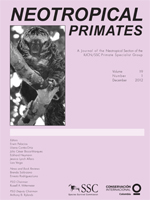Body size and the size of organs and other body structures are intimately related to the life history and ecology of a species (Temerin et al. 1984). Comparative analyses of data from different taxa can reveal allometric relationships and the adaptive value of different body or organ size (Martin 1990, Terborgh 1983). E.g., Terborgh (1992) showed the relationship between primate body size and dietary strategies. Ferrari et al. (1993) compared gut proportions of a specialized and an opportunistic gum feeder and showed the former to have a comparatively larger caecum, as an adaptation to the fermentation of gums. Morphometric data from skulls and skeletons can be obtained from museum material, but data on fresh body mass and on organ size or mass are generally not available from museum specimen. Given ethical implications and the increasing threat to wild primates, collecting wild primates for the purpose of obtaining organ size data is prohibitive. It is therefore imperative to exploit opportunities for taking morphometric data without collection, e.g. when a fresh carcass is found.
Table 1.
Morphometric measurements from the Callicebus cupreus female and comparative data from the literature

In this paper, we report morphometric data from a wild female red titi monkey, Callicebus cupreus, at the Estación Biológica Quebrada Blanco (EBQB) in north-eastern Peruvian Amazonia. This female was a member of one study group and found in a comatose state below the sleeping tree on early morning of 29 September 2002. It died a few hours later and was subjected to a field necropsy by the senior author, a trained veterinarian. For a detailed case report and the pathological findings see Müller et al. (2010). We measured body mass, head-body length, tail length and hind foot length on the fresh carcass with Pesola spring balances and a Vernon calliper, respectively. Skull length was measured before the braincase was opened for brain inspection and removal. After necropsy, skull and skeletal material were buried, to allow for decomposition of flesh, and recovered later. Unfortunately, part of the material was taken by scavengers. The remaining material was stored at EBQB and measured with a Mitutoyo CD-20DCX digital calliper by the first author in October 2012. Each variable was measured three times with and values were averaged.
Morphometric data collected before and during necropsy, and from the skull and skeletal material are provided in Table 1, together with data compiled from the literature. For many measurements taken here, actually no comparative data are available from the literature. Most skeletal and dental measurements are within or close to the range of values reported in the literature. The comparatively low body mass is likely due to the diseased condition. It should be note that data for liver, spleen and adrenal, perhaps also for kidney may also represent pathological conditions (Müller et al. 2010).
Acknowledgements
The study during which these data were collected was supported by a grant from the Deutsche Forschungsgemeinschaft to EWH (DFG He 1870/13-1) and from the Deutsche Akademische Austauschdienst (DAAD) to BM, and carried out under permission from the Instituto Nacional de Recursos Naturales (INRENA) in Lima (Peru). We thank Ney Shahuano Tello for field assistance, and biology students Victor Raygada Guerra and Cristina Lopez Wong from the Universidad Nacional de la Amazonía Peruana in Iquitos (Peru) for their help with the field necropsy.





